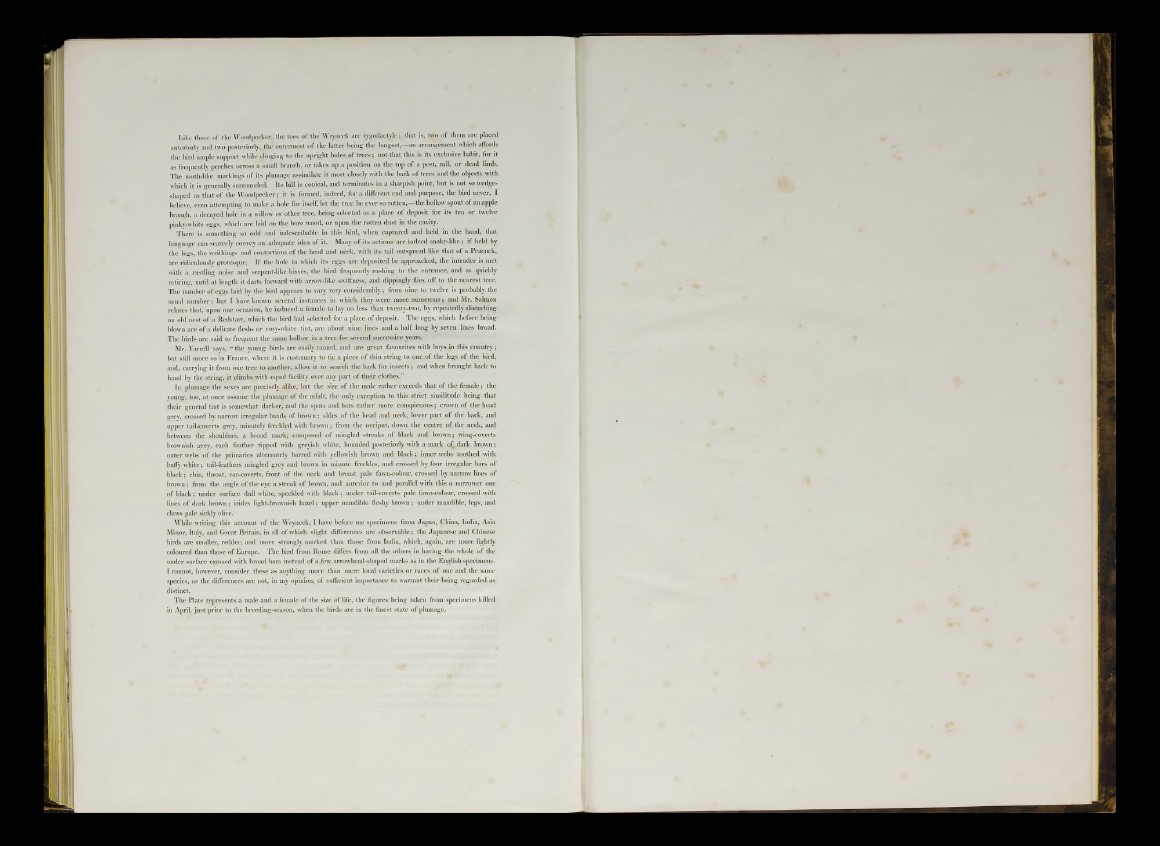
Like those of the Woodpecker, the toes of the Wryneck are zygodaetyle; that is, two of them are placed
anteriorly and two posteriorly, the outermost of the latter heing the longest,—an arrangement which affords
the bird ample support while clinging to the upright boles of trees; not that this is its exclusive habit, for it
as frequently perches across a small branch, or takes up a position on the top of a post, rail, or dead limb.
The moth-like markings of its plumage assimilate it most closely with the bark of trees and the objects with
which it is generally surrounded. Its bill is conical, and terminates in a sharpish point, but is not so wedge-
shaped as that of the Woodpecker; it is formed, indeed, for a different end and purpose, the bird never, I
believe, even attempting to make a hole for itself, let the tree he ever so rotten,—the hollow spout of an apple
branoh, a decayed hole in a willow or other tree, being selected as a place of deposit for its ten or twelve
pinky-white eggs, which are laid on the bare wood, or upon the rotten dust in the cavity.
There is something so odd and indescribable in this bird, when captured and held in the hand, that
language can scarcely convey an adequate idea of it. Many of its actions are indeed snake-like; if held by
the legs, the writhings and contortions of the head and neck, with its tail outspread like that of a Peacock,
are ridiculously grotesque. If the hole in which its eggs are deposited be approached, the intruder is met
with a rustling noise and serpent-like hisses, the bird frequently rushing to the entrance, and as quickly
retiring, until at length it darts forward with arrow-like swiftness, and dippingly flies off to the nearest tree.
The number of eggs laid by the bird appears to vary very considerably; from nine to twelve is probably the
usual number; but I have known several instances in which they were more numerous; and Mr. Salmon
relates that, upon one occasion, he induced a female to lay no less than twenty-two, by repeatedly disturbing
an old nest of a Redstart, which the bird had selected for a place of deposit. The eggs, which before being
blown are of a delicate flesh- or rosy-white tint, are about nine lines and a half long by seven lines broad.
The birds are said to frequent the same hollow in a tree for several successive years.
Mr. Yarrell says, “ the young birds are easily tamed, and are great favourites with boys in this country;
but still more so in France, where it is customary to tie a piece of thin string to one of the legs of the birdj
and, carrying it from one tree to another, allow it to search the bark for insects; and when brought back to
hand by the string, it climbs with equal facility over any part of their clothes.”
In plumage the sexes are precisely alike, but the size of the male rather exceeds that of the female; the
young, too, at once assume the plumage of the adult, the only exception to this strict similitude being that
their general tint is somewhat darker, and the spots and bars rather more conspicuous; crown of the head
grey, crossed by narrow irregular bands of brown; sides of the head and neck, lower part of the back, and
upper tail-coverts grey, minutely freckled with brown; from the occiput, down the centre of the neck, and
between the shoulders, a broad mark, composed of mingled streaks of black and brown; wing-coverts
brownish grey, each feather tipped with greyish white, bounded posteriorly with a mark o^dark brown;
outer webs of the primaries alternately barred with yellowish brown and black; inner webs toothed with
bufly white; tail-feathers mingled grey and brown in minute freckles, and crossed by four irregular bars of
black; chin, throat, ear-coverts, front of the neck and breast pale fawn-colour, crossed by narrow lines of
brown; from the angle of the eye a streak of brown, and anterior to and parallel with this a narrower one
of black; under surface dull white, speckled with black; under tail-coverts pale fawn-colour, crossed with
lines of dark brown; irides light-brownish hazel; upper mandible fleshy brown; under mandible, legs, and
claws pale sickly olive.
While writing this account of the Wryneck, I have before me specimens from Japan, China, India, Asia
Minor, Italy, and Great Britain, in all of which slight differences are observable; the Japanese and Chinese
birds are smaller, redder, and more strongly marked than those from India, which, again, are more lightly
coloured than those of Europe. The bird from Rome differs from all the others in having^ the whole of the
under surface crossed with broad bars instead of a few arrowhead-shaped marks as in the English specimens.
I cannot, however, consider these as anything more than mere local varieties or races of one and the same
species, as the differences are not, in my opinion, of sufficient importance to warrant their being regarded as
distinct.
The Plate represents a male and a female of the size of life, the figures being taken from specimens killed-
in April, just prior to the breeding-season, when the birds are in the finest state of plumage.